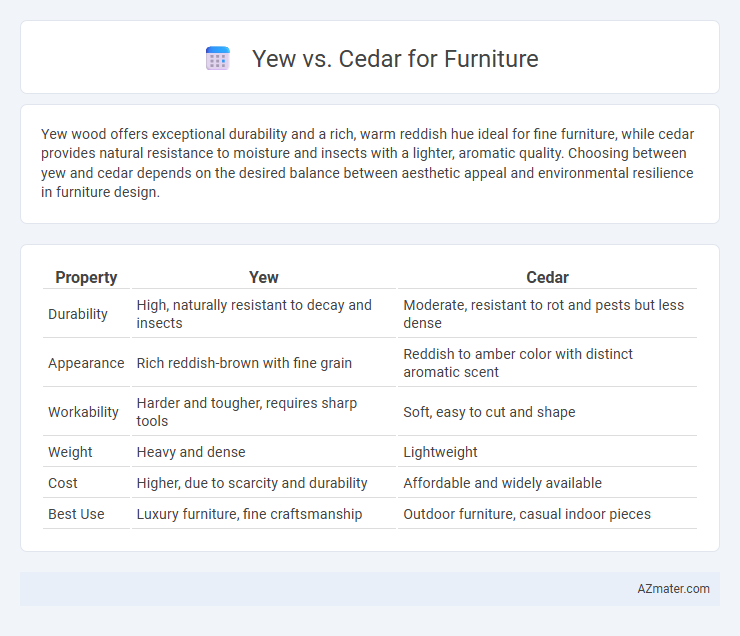Yew wood offers exceptional durability and a rich, warm reddish hue ideal for fine furniture, while cedar provides natural resistance to moisture and insects with a lighter, aromatic quality. Choosing between yew and cedar depends on the desired balance between aesthetic appeal and environmental resilience in furniture design.
Table of Comparison
| Property | Yew | Cedar |
|---|---|---|
| Durability | High, naturally resistant to decay and insects | Moderate, resistant to rot and pests but less dense |
| Appearance | Rich reddish-brown with fine grain | Reddish to amber color with distinct aromatic scent |
| Workability | Harder and tougher, requires sharp tools | Soft, easy to cut and shape |
| Weight | Heavy and dense | Lightweight |
| Cost | Higher, due to scarcity and durability | Affordable and widely available |
| Best Use | Luxury furniture, fine craftsmanship | Outdoor furniture, casual indoor pieces |
Introduction to Yew and Cedar Wood
Yew wood, known for its fine grain and rich yellow-brown hue, offers excellent durability and natural resistance to moisture, making it ideal for high-quality furniture pieces. Cedar wood features a distinct reddish tone with a pleasant aroma, prized for its lightweight properties and natural resistance to decay and insect damage. Both woods provide unique aesthetic and functional benefits, but vary significantly in hardness, weight, and finishing characteristics important for furniture applications.
Botanical and Historical Background
Yew (Taxus baccata) is a slow-growing, evergreen conifer native to Europe, known for its dense, fine-grained wood historically favored in medieval archery bows and prized for its durability and rich reddish-brown color in furniture making. Cedar, particularly Western Red Cedar (Thuja plicata), originates from the Pacific Northwest, valued for its aromatic, lightweight, and naturally rot-resistant timber used by Indigenous peoples for constructing canoes, longhouses, and detailed carvings. Both trees have deep botanical significance, with yew symbolizing immortality and protection in ancient European cultures, while cedar holds spiritual importance in Native American traditions for its purifying properties and long-lasting wood.
Physical Appearance and Color Differences
Yew wood exhibits a creamy yellow to light brown color with rich red hues and distinct grain patterns featuring fine, uniform texture, while cedar wood showcases a narrower color range with reddish-brown tones and prominent natural knots that add character. Yew's smooth surface and subtle sheen contrast with cedar's softer, more rustic appearance due to its loose grain and occasional streaks. These physical and color differences influence the choice for furniture, with yew offering a polished, warm elegance and cedar providing a cozy, aromatic ambiance.
Durability and Longevity Comparison
Yew wood offers moderate durability with natural resistance to decay but tends to be softer and more prone to dents compared to cedar, making it less ideal for high-traffic furniture. Cedar is renowned for its exceptional durability, resistance to moisture, and natural insect-repelling properties, contributing to superior longevity, especially in outdoor or humid environments. Choosing cedar for furniture ensures extended lifespan and minimal maintenance, whereas yew may require more care to preserve its appearance and structural integrity over time.
Workability and Ease of Crafting
Yew wood offers excellent workability due to its fine grain and moderate hardness, allowing for smooth finishes and detailed carving, making it highly favored for intricate furniture designs. Cedar, while softer and easier to cut, may splinter more easily but provides a pleasant aroma and natural resistance to rot, ideal for outdoor or rustic furniture. Both woods are workable, but Yew demands more skill for precision, whereas Cedar allows for quicker crafting with less effort.
Resistance to Decay and Pests
Yew wood exhibits moderate resistance to decay and pests, making it durable but less resilient than cedar. Cedar is highly valued for its natural oils that provide exceptional resistance to decay, insects, and mold, ensuring longevity in outdoor furniture. The superior pest-repellent properties of cedar make it a preferred choice for furniture subject to moisture and insect exposure.
Scent and Allergenic Properties
Yew wood emits a subtle, fresh aroma that is less likely to trigger allergic reactions compared to cedar's strong, pungent scent, which can cause respiratory irritation in sensitive individuals. Cedar furniture often contains natural oils that act as insect repellents but may exacerbate allergies or asthma symptoms due to volatile organic compounds (VOCs). Choosing yew can be favorable for indoor use where minimal allergenic impact and a mild fragrance are desired.
Environmental Impact and Sustainability
Yew wood is highly valued for its durability and slow growth, which can result in a higher environmental impact due to longer harvesting cycles and potential overharvesting risks. Cedar, particularly Western Red Cedar, is often considered more sustainable due to faster growth rates and natural resistance to decay, reducing the need for chemical treatments in furniture production. Choosing cedar over yew for furniture supports forest management practices that promote sustainability and minimize ecological disruption.
Cost and Availability Analysis
Yew wood is generally more expensive than cedar due to its slower growth rate and limited supply, making it a pricier option for furniture manufacturing. Cedar is widely available and grows faster, resulting in lower costs and easier access for producers and consumers alike. Both woods offer durability, but the cost-effectiveness and abundance of cedar often make it the preferred choice for budget-conscious furniture buyers.
Best Applications for Yew and Cedar Furniture
Yew wood is best suited for intricate indoor furniture like cabinets and decorative pieces due to its fine grain, rich color, and natural resistance to decay. Cedar furniture thrives in outdoor and rustic settings, offering durability, natural insect repellence, and resistance to moisture, which makes it ideal for garden benches, patio sets, and sheds. Selecting Yew enhances aesthetic appeal in controlled environments, while Cedar ensures longevity and performance in exposed, weather-prone locations.

Infographic: Yew vs Cedar for Furniture
 azmater.com
azmater.com